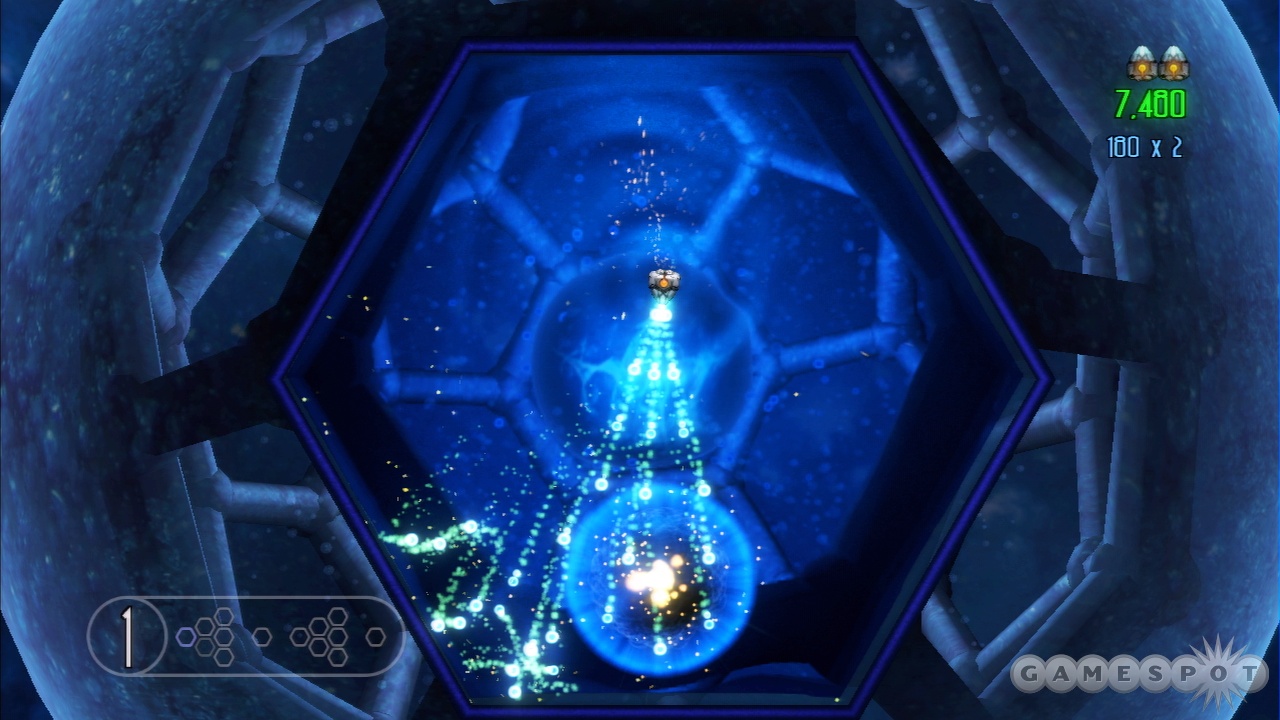Blast Factor is one of the first downloadable games for the PlayStation 3. It's a fixed-screen shooter that bears an uncanny resemblance to the popular Geometry Wars on the Xbox 360. But despite feeling very familiar, Blast Factor does add a couple of unique twists that make it a little more than just a clone of a clone. The problem is that it’s just too short and simple to last for more than a couple of hours, and it leaves no lasting impression beyond that.

You are the pilot of a G-18 Nanite Interceptor, which is a tiny ship that is injected into infected "specimens" to destroy viruses. There are seven specimens in all, and each one contains several screens that you have to clear. Each screen is a hexagonal "cell" full of fluid and various colored viruses that skitter about. It's your job to clear the viruses out of the cell by shooting them. Once you've cleared a few waves of viruses, you'll move on to the next cell.
Depending on how you perform, you can take multiple paths through each specimen. So if you perform expertly on the first cell, you'll move on to the "hard" cell, but if you die once or twice on the first cell, you'll instead move on to the "easy" cell. Each specimen has a series of six cells to clear, with a bonus cell in the middle and a boss--or "nano-core"--cell at the end. The bonus cell has you killing as many viruses as you can within a limited time, which increases your score and nets you an extra life. The boss cell is the same for each specimen, which is disappointing because the boss isn't very interesting or fun to fight, and it doesn't pose much of a challenge. In fact, the boss cell is usually the easiest cell in each specimen.
For the most part this game plays like an average shoot-'em-up. You move with the left analog stick and fire by pointing the right analog stick in any direction. This lets you move in one direction while firing in another. You have unlimited ammo and a fast rate of fire, but that doesn't make it easy to shoot the small, fast-moving viruses. You can get power-ups such as homing shots and a three-way shot, but these items are few and far between, and they don't last very long once you get them. When the swarms of viruses get out of hand you can press either the L2 or R2 button to activate your "repulsor," which generates a small force field that will push viruses away from you, though it usually won't kill them. The only limit on using the repulsor is that you have to wait a couple of seconds for it to charge between uses.
The most interesting twist Blast Factor offers on the familiar formula is the ability to tilt the level using the Sixaxis controller's motion sensor. By tilting the controller to the left or right, you can tilt the cell, which creates a wave in the fluid that sloshes from one side of the screen to the other. This is useful because the wave doesn't affect your movement, but it does push all the viruses to one side of the screen. It's an interesting mechanic that takes a while to get used to, and it can backfire. Sometimes you might accidentally tilt the controller when you didn't mean to, and other times you might tilt the controller one way only to have the wave come from the wrong side and wash a bunch of enemies into you. Aside from these occasional issues, the motion sensor control works fairly well, and it adds another hectic layer to the already frantic pace of the game.
You start off with three lives, and there are several opportunities to pick up extra lives as you play. When your lives are depleted, you can continue from the last checkpoint, which is never more than two cells back. You have infinite continues as well, which means that if you're dedicated and moderately skilled at games of this type, you can sit down and finish the game in an hour or two. That isn't to say it's easy, though. The last couple of levels get pretty intense, though they never seem overly punishing. Even when you've died 10 times on the same cell, you'll feel that if you try one more time you just might beat it.

The presentation in Blast Factor is bland and generic. The backgrounds are dull and never change from cell to cell, and the viruses are all nondescript and just kind of float around without much of a pattern. There are some larger enemies, like metal blobs that have to be flipped over by a wave before you can kill them, but for the most part the only variety you'll find is in the color. Some viruses are yellow, some are gray, and others are green, but they still all look and behave mostly the same. The most disappointing element of the presentation is the sound. There's no music, so all you'll hear while playing is the repetitive sound of your blaster fire, peppered with an occasional explosion as you destroy an enemy or group of enemies. Mostly the lack of music just adds to the generic feel of the game.
Blast Factor is selling for $7.99 during the launch of the PlayStation 3, but the advertised regular price is $9.99, which is a bit high for a game that you'll probably spend only a couple of hours with and then forget. The motion sensor control is an interesting twist, but other than that there's very little about this game that's in any way remarkable.



